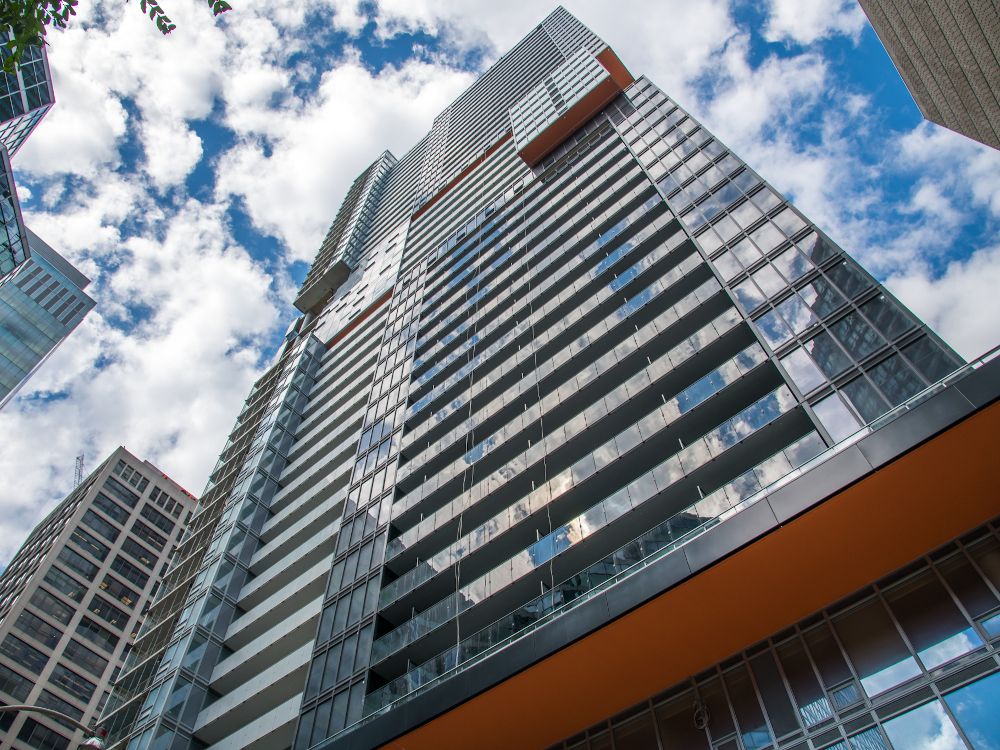LNahid2000
Senior Member
The retail tenant has finally been announced!

Until recently, a building like the Livmore, a new 43-storey, 595-unit housing tower in downtown Toronto, would have been a rarity in the city. Not just because of its unique mix of amenities — which includes a dog spa, an outdoor dog park and a two-storey sky lounge — but because it’s a purpose-built rental, not a condo like many of its Bay Street neighbours.
Structures such as the Livmore were once common in Toronto. Between the mid-1960s and 1970s, developers built 140,000 rental apartment units, a number that started to dwindle when Ontario’s introduced modern rent controls in 1975. Those controls protected the budgets of existing tenants, but limited the return on investment for developers’. By the 2000s, little more than a thousand units were coming onto the market every year — or less than 10 per cent of the number of condo units completed over the same period.
For a long time, the economics of constructing a rental made little sense compared to a condo. Condo builders get a significant portion of their financing directly from future unit owners, who give hefty deposits to secure their spot and therefore assume some of the risk. Rental landlords, on the other hand, need to front the majority of the equity, assuming all the risk themselves. When a condo building is complete and all the units have been sold and paid for, the developers quickly reap the returns on their investment and move on. For a rental building, the returns take many, many years longer.
“Planning for the Livmore began over 10 years ago, in 2008,” says Todd Nishimura, director of marketing and leasing at GWL Realty Advisors, the company that owns the project. Tenants started moving into the building in September 2018, with full occupancy expected in 2020. That 11- to 12-year delay from conception to rent collecting would be impossible to shoulder for many investors except the largest institutions. (GWL is backed by the financial-services holding company Great-West Lifeco.)
To rectify the imbalance, in 2017 the federal Liberal government introduced a $2.5-billion, CMHC-backed program offering low-interest, long-term loans to rental developers. Currently, rates are between 1.5 and 3 per cent, with loans locked in for 10 years. So far, the program has helped fund some 12,000 new rental units across the country. Those include 761 units in a massive three-tower development in Toronto’s West Don Lands by Tricon Capital Group and Dream Unlimited Corp., which received $357 million in federal financing. The program has been so popular that the government is increasing the fund to $14 billion by 2028.
Also helping: Ontario’s Progressive Conservative government decided to both defer development fees for new purpose-built rentals — offsetting upfront financing costs — and limit rent controls to structures built before 2018. Previously, when the now-departed Liberal government tightened rent controls in 2017, developers turned 1,000 planned rental units into condos. Now, potentially higher profits are incentivizing them to get back into the rental game.
“Things have moderated a bit,” Rygier explains. “Instead of competing with six or eight other tenants, now people are competing with three or four. And rents are still rising, just not as much as a few years ago.”
Overall, though, prices are staying high because demand is still far outstripping supply. Each year, approximately 22,000 new renters are coming to Toronto every year. According to a recent report by RBC Economics, rental stock would have to expand by 26,800 units over the next few years in order to catch up with the current backlog and for prices to level off.
“There are lots of things we can do in the city to increase rental development,” says David Sajecki, an urban planner who often consults with builders interested in rental housing. “The city could loosen zoning regulations prohibiting building in the yellow-belly” — the 70 per cent of the city currently restricted to single-family housing. “That would free up more land for what I call ‘gentle density,’ small-scale buildings that allow more people to live in established neighbourhoods. We could also give HST credits to those involved in building, to make their development more competitive with condo builders.”
Further refining rent controls could also bolster interest from developers. “It seems we have flip-flops, where people don’t know what the rules will be from administration to administration,” says Dr. Jim Clayton, the director of the Brookfield Centre in Real Estate & Infrastructure at York University’s Schulich School of Business. Ambiguity in such an important policy heightens risk. Especially given the long time horizons of a construction project, developers don’t want to start a building under one set of regulations only to find those regulations voided by a change in government.
As well, there might be more effective ways to approach such legislation. “Maybe we should have income-tested controls,” says Clayton, “so that high-income professionals don’t stay in rent-controlled places, limiting supply for people who might need it more.”
One 2019 study from Stanford University in California suggested that government rebates or subsidies would benefit tenants subjected to rent hikes more effectively than traditional controls would. Otherwise, the researchers found, rent controls disproportionately benefit existing tenants (who tend to be older and less likely to move), while reducing supply for new renters (who tend to be younger), driving up their cost of living. The researchers also suggested that unchecked gentrification is another consequence of rent controls, as developers start building more condos and fewer rentals when controls tighten.

One 2019 study from Stanford University in California...
Despite the economic uncertainty caused by the COVID-19 (coronavirus) pandemic, Toronto-based Fresh City, a leading provider of organic, sustainable, and seasonal fresh food, has expanded.
The company has opened a new store — its second Fresh City store — at the corner of Bay Street and Gerrard Street to serve the grocery needs of thousands of front-line workers at nearby hospitals. The store, which is located at the base of The Livmore residential rental building, has scaled back its offering in light of risks posed by the coronavirus pandemic, it said.
“Our purpose is to create a better life through food. At this unprecedented time, we want to make it easier for hospital workers and nearby residents to have safe access to food. This location is steps away from five iconic research hospitals and opening now is one way that we can thank the hospital staff for everything they are doing,” said Ran Goel, the company’s founder and CEO, who added that all hospital workers are being offered a 10 per cent discount on grab & go fresh prepared items and single beverages.
"It is the least we can do. They are the ones who are putting themselves at risk and working overtime during this crisis. They are our health care heroes."

 www.retail-insider.com
www.retail-insider.com
Why was it turned off? Was it bothering the residents or something?It's unfortunate the accent lighting under the overhangs was turned off shortly after the building opened to residents.
Accent lighting? I don't remember seeing this.It's unfortunate the accent lighting under the overhangs was turned off shortly after the building opened to residents.
It was very short lived.Accent lighting? I don't remember seeing this.